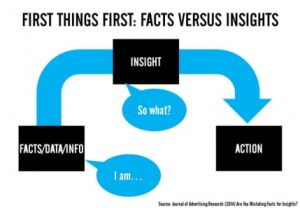 Data, information and insights are sometimes used as interchangeable terms but are not the same thing. Sometimes people use “data” and “information” to refer to the same sets of information, but the reality is that they are in fact very different. The best way to think of these categories is by separating them into a pyramid. Data would fall at the very bottom of the pyramid, information in the middle, and insights at the very top.
Data, information and insights are sometimes used as interchangeable terms but are not the same thing. Sometimes people use “data” and “information” to refer to the same sets of information, but the reality is that they are in fact very different. The best way to think of these categories is by separating them into a pyramid. Data would fall at the very bottom of the pyramid, information in the middle, and insights at the very top.
Data can essentially be thought of as information that has not yet been processed or decoded. When marketing companies issue surveys and consumers give their answers, the results collected and placed on a spreadsheet would be considered data. Data is measured and collected. Once it has been collected, it can be analyzed and constructed into graphs and images so that it can be accurately analyzed. Once it  is analyzed and viewed, it becomes information. Information is data which has already gone through the decoding and processing stage. Once the information is interpreted, it is easier to digest and understand. When data is first acquired, it is raw and not much can be done with it in this form. By organizing this data, marketers can retrieve information which adds some kind of meaning to these results. Information is knowledge about a particular subject that can assist consumers in their decision-making process. Insights are then taken from the information gathered. Insights refer to the way people take in and process information. During this step, observations can be made, and conclusions drawn based on whatever information is consumed. Insight is a precursor to action, or what people will do based on the conclusions they have made with the insights.
is analyzed and viewed, it becomes information. Information is data which has already gone through the decoding and processing stage. Once the information is interpreted, it is easier to digest and understand. When data is first acquired, it is raw and not much can be done with it in this form. By organizing this data, marketers can retrieve information which adds some kind of meaning to these results. Information is knowledge about a particular subject that can assist consumers in their decision-making process. Insights are then taken from the information gathered. Insights refer to the way people take in and process information. During this step, observations can be made, and conclusions drawn based on whatever information is consumed. Insight is a precursor to action, or what people will do based on the conclusions they have made with the insights.
Data driven organizations have a primary goal of obtaining data, using it to interpret the information needed, and creating insights that can be utilized to propel a business and make important decisions. One of the reasons data and insights are often confused is because they are both related to information. In fact, many people  inaccurately believe that data is an insight. It’s important to note that it is near impossible to find insights without data, but they aren’t the same thing! As a marketer, if you work for a cosmetics company it may be an essential component of your job to understand that most of the consumers of a particular makeup brand are women. That’s an important data point, not an insight. However, an insight made from this gathered data might be that it is once of the most admired and successful cosmetics brands globally and that women prefer to buy from this brand over any other.
inaccurately believe that data is an insight. It’s important to note that it is near impossible to find insights without data, but they aren’t the same thing! As a marketer, if you work for a cosmetics company it may be an essential component of your job to understand that most of the consumers of a particular makeup brand are women. That’s an important data point, not an insight. However, an insight made from this gathered data might be that it is once of the most admired and successful cosmetics brands globally and that women prefer to buy from this brand over any other.
 There isn’t much that a marketer can do with a data point. However, by reaching an insight a marketer can learn to create a marketing strategy to market to these particular consumers in a way that will grasp their attention and differentiate the brand from its competitors. From here, marketers can hash out a master plan that will fuel the growth of the company.
There isn’t much that a marketer can do with a data point. However, by reaching an insight a marketer can learn to create a marketing strategy to market to these particular consumers in a way that will grasp their attention and differentiate the brand from its competitors. From here, marketers can hash out a master plan that will fuel the growth of the company.
Data points are the start of this information process and everything unfolds from there. The purpose of insightful marketing is to best understand what drives consumers to make a purchase. Insights bring value for marketing goals and can lead to competitive advantages, so it is important to understand the differences and similarities in order to arrive to the correct interpretations and create successful strategies.